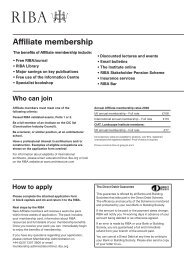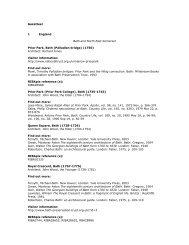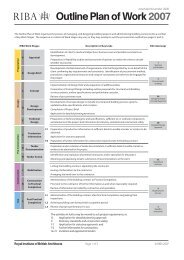Albertopolis Walking Tour: transcript - Royal Institute of British ...
Albertopolis Walking Tour: transcript - Royal Institute of British ...
Albertopolis Walking Tour: transcript - Royal Institute of British ...
You also want an ePaper? Increase the reach of your titles
YUMPU automatically turns print PDFs into web optimized ePapers that Google loves.
7. Albert Memorial<br />
13.37mins<br />
The 53 metre high Albert Memorial has been a<br />
London landmark since its unveiling in 1872.<br />
Following the sudden death <strong>of</strong> her beloved Prince<br />
Albert from typhoid in 1861, Queen Victoria very<br />
quickly decided that a memorial should be built to<br />
honour her late husband. She invited seven leading<br />
architects to submit designs for a monument to be<br />
built in Kensington Gardens. It was to be located just<br />
to the north <strong>of</strong> the museums area which Albert had<br />
helped to build up, and to the west <strong>of</strong> where the<br />
Great Exhibition had been held.<br />
The results <strong>of</strong> the competition were announced in<br />
April 1863. George Gilbert Scott was the winner, with<br />
his ornate design for a canopy or tabernacle in the<br />
Gothic style, containing a seated statue <strong>of</strong> Albert.<br />
Work began on constructing the memorial in 1864<br />
and in 1872 the 176 feet or 53 metre high memorial<br />
was opened, although it was not completely finished<br />
until 1876. The monument cost £120,000 to build, a<br />
large sum at the time, due in part to the luxurious<br />
materials used and the numerous craftsmen involved.<br />
The 24ct gold statue <strong>of</strong> Albert was completed by the<br />
sculptor John Henry Foley. The prince is dressed as a<br />
Knight <strong>of</strong> the Garter and is sat holding a catalogue to<br />
the Great Exhibition <strong>of</strong> 1851. The memorial contains<br />
many references to Albert’s interests and his work in<br />
the field <strong>of</strong> arts and science education.<br />
At the base <strong>of</strong> the canopy runs a frieze in which is the<br />
following inscription:<br />
Statue <strong>of</strong> Prince Albert, preliminary<br />
model for the Albert Memorial,<br />
c.1863<br />
Copyright: V&A Images<br />
“Queen Victoria and her people - A tribute to the memory <strong>of</strong> Albert Prince Consort –<br />
As a Tribute <strong>of</strong> their gratitude – for a life dedicated to the public good.”<br />
The mosaics for each side <strong>of</strong> the canopy and beneath it were designed by Clayton and Bell<br />
and manufactured by the firm <strong>of</strong> Salviati in Venice.<br />
The podium <strong>of</strong> the memorial is surrounded by an elaborate sculptural frieze, depicting 169<br />
individual composers, architects, poets, painters, and sculptors, all carved by Henry Hugh<br />
Armstead and John Birnie Philip.<br />
At the four corners <strong>of</strong> the podium, below the statue <strong>of</strong> the prince, are allegorical marble<br />
sculptures <strong>of</strong> agriculture, commerce, engineering and manufacturing. At the outermost<br />
corners are allegorical stone sculptures <strong>of</strong> Europe, Asia, Africa, & the Americas, reflecting<br />
Albert’s international concerns.<br />
8










